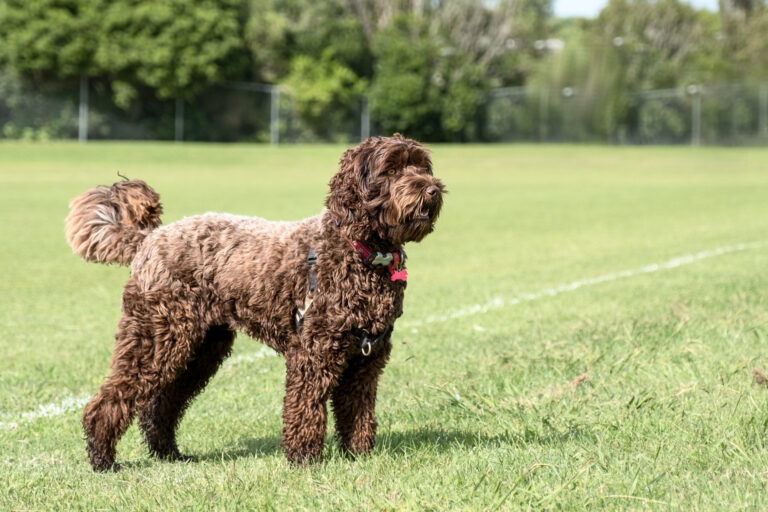The Labradoodle is a much-loved mixed breed, and among them, the Chocolate Labradoodle stands out with its warm, cocoa-colored coat.
Many families are charmed by this crossbreed, which inherits the smarts and loving nature of its Labrador Retriever and Poodle parents.
These dogs adjust well to different home environments, and their willingness to learn makes training them quite straightforward.
Regular grooming is necessary to maintain their beautiful coat and avoid knots.
Plus, they need plenty of interaction and exercise, so prepare for lots of active fun, like playing fetch or going for brisk walks.
Key Takeaways
- Exercise, diet, and grooming keep your Labradoodle thriving.
- Monitor for breed-specific health issues to maintain wellness.
- Labradoodles are perfect for active families with older children.
Quick Facts
If you’re interested in Chocolate Labradoodles, it’s good to know they can grow to about 65 pounds for the standard size, or roughly 20 pounds if you opt for a miniature.
These puppies sport a deep chocolate coat, which can be quite rare, often needing a skilled breeder like those found at Crockett Doodles to achieve. The genes responsible for this dark color require careful selection to make sure the coat’s color stays true and vibrant.
Chocolate Labradoodles also have a curly coat that demands consistent grooming to keep it looking great and healthy.
Their unique fur is an asset, as it makes them a great choice for people with allergies due to its hypoallergenic properties.
Overview
Considering a Chocolate Labradoodle for your family? These dogs stand out for their hypoallergenic fur, which is great for people with allergies. Their unique brown hue is thanks to a certain gene that affects coat color. It’s the less common allele responsible for the chocolate color that makes them so visually unique.
When you think about bringing a Chocolate Labradoodle into your home, remember that they’re full of energy and need plenty of exercise to stay healthy. They thrive on human connection, so a loving home where they can get lots of attention is ideal. Choosing a Chocolate Labradoodle is more than just falling for their looks; it’s about being ready to meet their exercise and companionship needs.
Key Features
Key Features of Chocolate Labradoodles
Chocolate Labradoodles are known for their striking dark brown coat. This color comes from a unique genetic mix that creates shades varying from a light milky brown to an intense dark chocolate. The specific tone your Labradoodle might have is influenced by their genes and the environment they live in.
When looking at the spectrum of sizes, Chocolate Labradoodles can vary greatly. A standard-sized Labradoodle can weigh up to 65 pounds, while the mini versions typically weigh around 20 pounds. With their low-shedding coats, these dogs are often a great match for individuals with allergies.
As for their coat type, Chocolate Labradoodles have a soft and curly fur that can range from gently wavy to a more woolly texture. This variety in coat texture means they can suit a wide range of preferences, whether you’re looking for a dog with a plush feel or one with a more rugged coat.
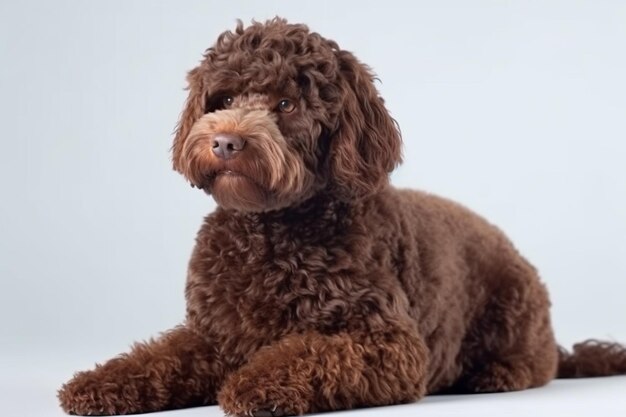
Breed Origin
The Chocolate Labradoodle has an interesting origin story. It was intentionally created in Australia to meet a specific need. The journey began in 1989 when Wally Conron crossed a Poodle and a Labrador Retriever. The goal was to produce a dog that combined the Poodle’s hypoallergenic coat with the Labrador’s friendly nature. This was particularly aimed at helping people with allergies who needed a guide dog.
This thoughtful approach shows the careful planning that went into designing the Labradoodle breed.
Poodle-Labrador Mix Roots
The origins of the chocolate Labradoodle can be traced back to Australia in the late 1980s, thanks to the efforts of Wally Conron. He was the first to cross a Poodle with a Labrador Retriever, creating a breed known for its minimal shedding and easy training. The goal was to make a dog that would be a great helper for people with allergies without losing the best qualities of both parent breeds.
The unique look of your chocolate Labradoodle comes from a special combination of genes. A certain recessive gene, common in Labradors, shows up when it meets the right match in Poodle genetics. This specific genetic match brings out that rich chocolate color that makes your dog stand out.
Historical Labradoodle Development
The Labradoodle has an intriguing origin story that dates back to the late 1980s, when breeders aimed to create a dog that could assist those with allergies. Wally Conron played a pivotal role in this by mating Labrador Retrievers with Poodles, seeking to merge the Lab’s excellent guiding abilities with the Poodle’s allergy-friendly coat.
From these breeding efforts, chocolate Labradoodles were born, showcasing a wide range of genetic variation. These dogs, with their dark brown coats, became a testament to the successful effort of meeting specific human needs through selective breeding, ensuring both beauty and practicality in their design.
Initial Breeding Purposes
If you’re on the lookout for a dog that won’t trigger allergies and is smart, you might find the history of the chocolate Labradoodle interesting. This breed is a deliberate mix, combining the low-shedding coat of Poodles with the friendly nature of Labrador Retrievers.
The initial Labradoodle generation was carefully bred to reduce the presence of allergens while ensuring the dogs remained easy to train for service jobs. The reason for creating Labradoodles was dual: they needed to be safe for people with allergies who required a guide dog, and they also had to preserve the intelligence and social skills of their parent breeds.
The breeding was carefully planned to create a dog that could work and provide company, all while being safe for people with allergies.
Growth Expectations
When you bring a Chocolate Labradoodle into your home, knowing how big they’ll get is key to keeping them healthy and happy. A full-grown standard Chocolate Labradoodle can tip the scales at up to 65 pounds.
During their first six months, these pups typically pack on pounds quickly, but their weight gain will slow as they get older. You’ll also notice that they shoot up in height mostly before their first birthday.
As they move from being a playful puppy to a mature dog, it’s vital to give them the right food that meets their nutritional needs and supports their growth.
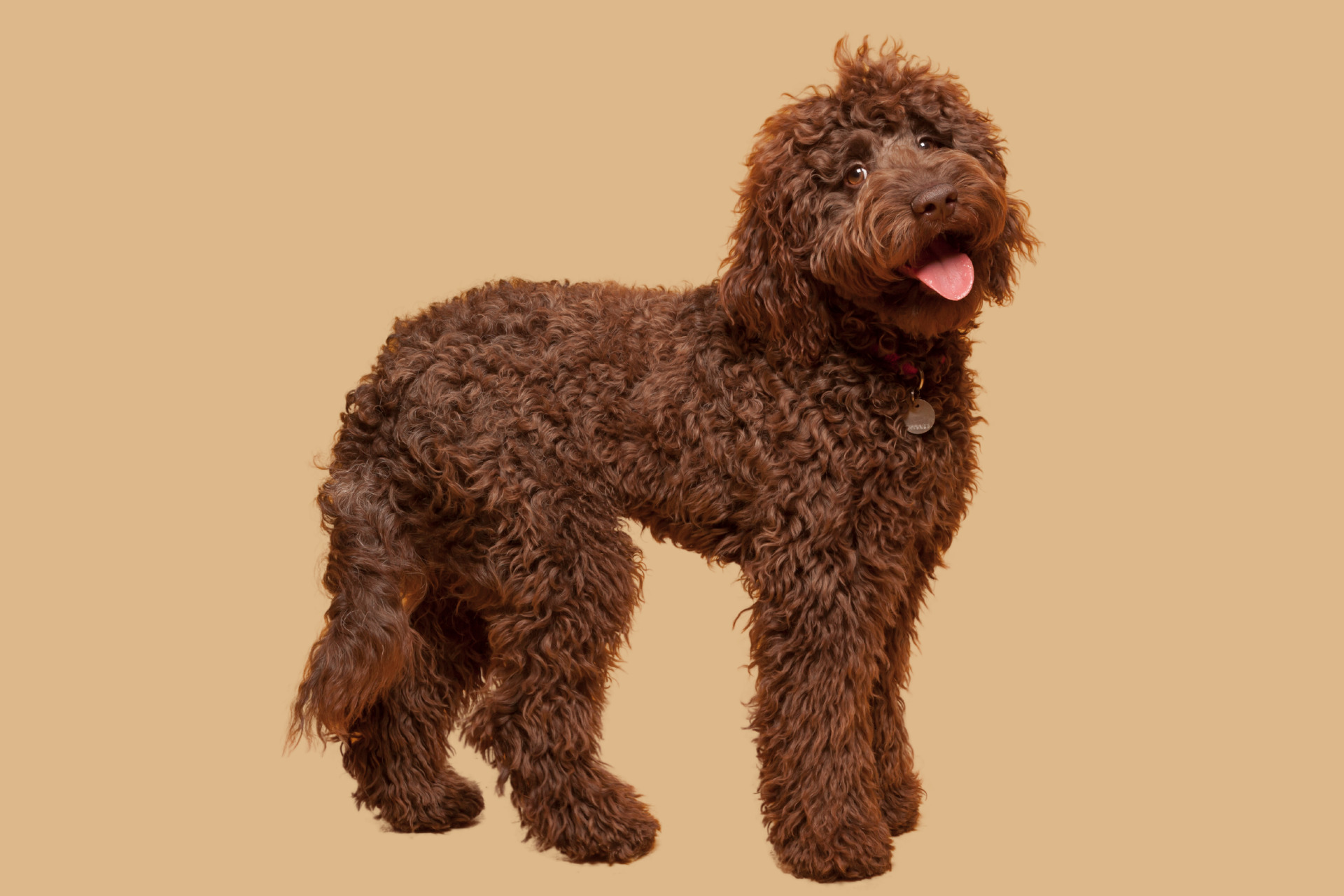
Average Adult Size
If you’re thinking about getting a Chocolate Labradoodle, be aware that their size can differ greatly depending on the type. A full-grown standard Chocolate Labradoodle might weigh as much as 65 lbs and often have a sturdy build with a moderate energy level, making them a great match for families that enjoy being active.
In contrast, the F1b mini Labradoodle, which is a cross between a Labradoodle and a purebred Poodle, usually weighs around 20 lbs and has a more petite frame, making it a good choice for smaller homes or apartments.
Regardless of their size, all Chocolate Labradoodles sport the distinctive chocolate-colored coat that comes from their specific genetic makeup, so when planning for your new pet, it’s wise to consider their breeding background to get an idea of their adult size.
Weight Gain Timeline
Your chocolate Labradoodle puppy will grow quickly, especially in the first six months. Mini Labradoodles tend to bulk up fast, often reaching their full size sooner than their larger counterparts. This quick growth means you need to watch their development closely to avoid health problems.
Regular check-ins on your Labradoodle’s body condition are key for healthy growth. Use rewards-based training to promote good eating habits and combat obesity, which can lead to joint issues and other health problems. Tracking your Labradoodle’s weight gain with a focus on science helps secure a strong and healthy life.
Height Development Stages
Your chocolate Labradoodle will go through various growth stages and is expected to reach its full size between 12 and 18 months. If you have a mini Labradoodle, its growth may level off earlier than the larger variety.
Keeping an eye on how much your puppy grows can help you predict its adult size and spot any health issues early on. Regular grooming is more than just keeping your dog looking good; it’s a chance to check on their growth progress.
Puppy to Adult Transition
As your chocolate Labradoodle grows, you’ll notice the pace of its growth slowing down. By the time it’s 18 months old, it should reach adult size. During their first year, these dogs typically grow quickly, with the larger ones reaching up to 65 lbs and the smaller versions leveling off at about 20 lbs.
It’s important to watch for health issues, as the chocolate color might make them more prone to certain conditions. For their wellbeing, regular grooming is necessary, which includes brushing and getting haircuts from a professional every six weeks.
Labradoodles are versatile and can thrive in both indoor and outdoor settings, as long as they have enough space to stay active and aren’t left alone for too long.

Nutrition for Growth
Feeding your chocolate Labradoodle the right nutrients for its growth stage is vital. Puppies especially need a diet that supports their tissue and bone development with the right mix of proteins, fats, carbohydrates, vitamins, and minerals. It’s wise to work with your vet to tailor their food to their growing needs and to head off any breed-specific health issues.
As your Labradoodle grows, their food needs to match their expected adult size—around 65 lbs for standard sizes and closer to 20 lbs for miniatures. Ensuring they get the proper nutrition early on can help prevent health problems related to their breed.

Temperament Traits
When looking into a Chocolate Labradoodle’s temperament, it’s essential to take into account how their social nature fits into various settings. You should also examine how well they adjust when given regular training and social interaction.
It’s interesting to see if their activity levels might influence their behavior in certain situations.
Lastly, it’s worth investigating if there’s a consistent temperament among different dogs and if their coat color has any effect on their personality.
These considerations will help you better understand what behavior to expect from a Chocolate Labradoodle.
Family-friendly Nature
Your new chocolate Labradoodle adds a cozy and energetic touch to your household with its friendly and loving personality. Studies on dog behavior show that Labradoodles make excellent family pets because of their even-tempered nature and ability to adapt to different situations.
Chocolate Labradoodles are known for their strong attachment to family members and consistently aim to please. They balance excitement and calmness well, which makes them perfect for playing with both kids and adults.
To keep their friendly nature around new people, it’s important to give them plenty of chances to socialize.
Training and Socialization
Understanding the personality of a chocolate Labradoodle means recognizing the need for regular training and social exposure. These dogs are often smart and learn quickly when trained properly. There might be differences in how easily each dog learns, depending on their genes and personalities. While many chocolate Labradoodles are keen to learn and react well to commands, others may need a gentler and more persistent training style.
Introducing them to new places and a variety of people early on helps them become friendly and confident adults. It’s vital to start this socialization early and keep it up as they grow, along with consistent training, to encourage their friendly and adaptable nature.
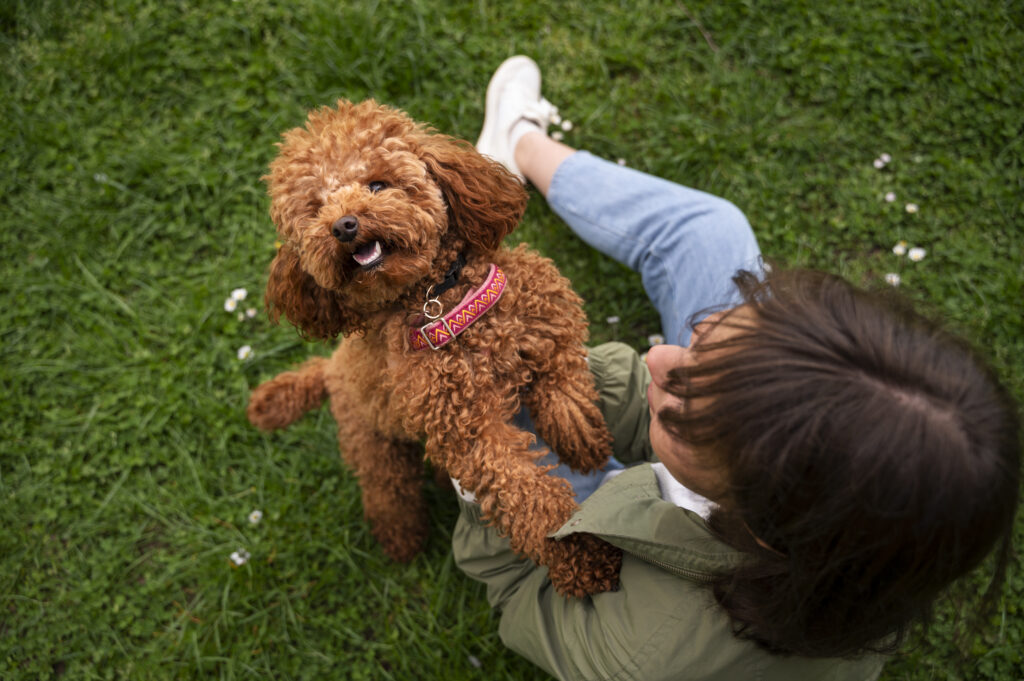
Energy Level Considerations
Labradoodles need plenty of exercise to maintain their happiness and health. These energetic dogs inherit the Labrador Retriever’s endurance and the Poodle’s agility, making them quite active.
Their natural affinity for water activities, like swimming, reflects their need for engaging play and exercise. Without enough interaction and physical activity, a Labradoodle might resort to chewing things up or barking a lot out of frustration.
Owners should establish a regular exercise plan that suits their high-spirited nature to avoid such issues.
Behavioral Consistency
Chocolate Labradoodles often display a blend of traits from both poodles and Labrador Retrievers. They combine the poodle’s sharp intelligence with the Labrador’s warm sociability. This mix usually results in a well-rounded dog suitable for a variety of roles, from companionship to service.
Poodles contribute their quick learning abilities, enhancing the Labradoodle’s skill in picking up new commands and solving problems. The Labrador’s easygoing and adaptable nature softens any reserved qualities passed down from the Poodle side.
A close look at their behavior shows they thrive on mental and physical engagement, highlighting why regular exercise and interactive play are vital for their happiness.
Color Impacting Temperament?
Can a dog’s coat color affect its behavior? Current research suggests that coat color might have a connection to a dog’s temperament, especially in the case of chocolate Labradors. A study in the journal Applied Animal Behavior found that chocolate labs tend to be more excitable, which could mean chocolate labradoodles might share this trait. It’s interesting to note, however, that a dog’s environment and upbringing are also critical in shaping their personality.
Scientists are investigating whether the genes responsible for the chocolate color in Labradors might also influence their behavior. Some believe that these genes could be linked to behavioral characteristics. Additionally, there’s a common belief that chocolate Labradors aren’t as healthy, which might impact their behavior and stress levels. However, more research is needed to fully understand this intriguing connection.
Health Considerations
Health Considerations for Chocolate Labradoodles
When adding a chocolate labradoodle to your family, it’s vital to consider its health needs. These dogs may inherit certain conditions, so it’s wise to understand any genetic risks that could affect their well-being. Regular health screenings are a must to detect any inherited diseases early on. Such proactive steps can lead to a longer life for your pet.
A balanced diet and consistent exercise are key to keeping your Labradoodle in good shape. Nutrition and activity are fundamental to preventing common health issues and ensuring your dog stays happy and healthy.
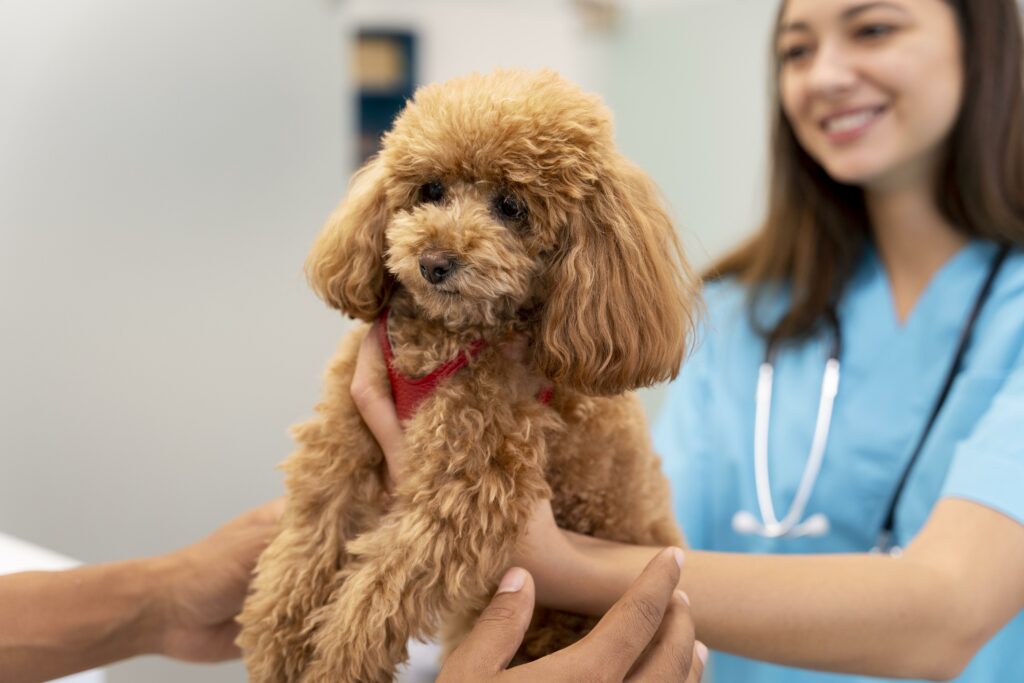
Inherited Conditions Risk
Your chocolate Labradoodle might inherit health problems such as hip and elbow dysplasia, which are common in the breed’s Labrador and Poodle ancestors. These conditions cause joint malformations, potentially resulting in discomfort, difficulty walking, and restricted movement.
The chocolate Labrador, one of the parent breeds, is particularly susceptible to these joint issues. Ear infections are also common in Labradoodles because their floppy ears can hold moisture, creating an environment for bacteria to thrive.
Responsible breeders conduct genetic screenings to reduce the spread of such hereditary conditions. The chocolate coat color in Labradors has been linked to a greater risk of specific health problems, so it’s vital to choose puppies from breeders who focus on genetic health.
Health Testing Importance
Health testing is vital when adopting a chocolate Labradoodle because it helps uncover potential health problems that may be passed down through genetics. A healthy pet is critical, and knowing the medical history of your Labradoodle’s parents is one way to ensure that. Detailed genetic screenings can pinpoint risks for certain diseases, which is key for maintaining the breed’s health standards.
Before you decide to bring a mini Labradoodle into your home, make sure you have proof of clean health records from the breeder. This step is essential in protecting not just the puppies but also contributing to the breed’s long-term well-being. It’s a move that supports the health of these dogs and helps maintain breed quality.
Ensuring Longevity
To help your chocolate Labradoodle thrive for years, focus on tailored care and consistent vet visits. Knowing the health risks related to their coat’s color and family history before you welcome a Labradoodle into your home matters.
The chocolate color may look great, but it can be associated with certain health challenges that need careful attention. It’s wise to conduct regular health screenings and keep up with grooming routines to prevent skin and coat issues.
For guidance on keeping your dog healthy, consider resources that offer detailed care methods for your dog. A loving and attentive environment is key to a long and happy life for your pet.
Grooming and Maintenance
Taking care of your Chocolate Labradoodle’s coat and health requires regular attention. Here’s a simple routine to keep them in great shape:
- Brush their fur at least three times every week to avoid tangles and keep their skin oils well-distributed.
- Give your dog a bath every three to five weeks, which may vary based on how active they’re and the condition of their coat.
- It’s best to clip their nails every two months to make sure they’re comfortable while walking and running.
- Don’t forget to clean their ears once a week to prevent infections, especially since these dogs love water.
Following this care routine will help keep your Labradoodle’s coat shiny and ensure they’re comfortable and content.
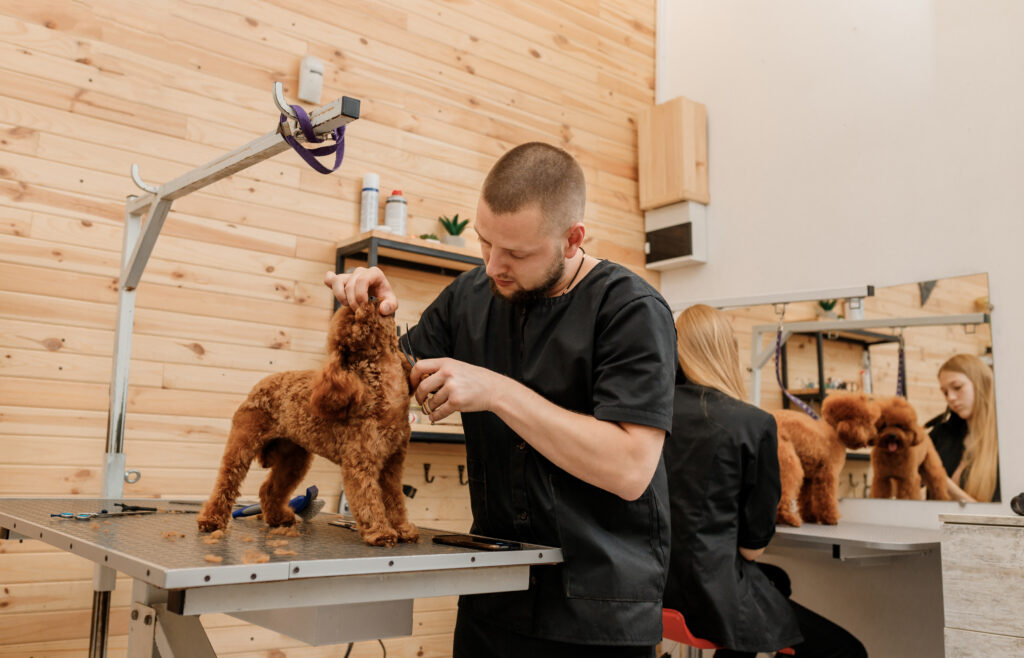
Coat Brushing Frequency
To keep a chocolate Labradoodle looking its best and avoid painful matting, it’s vital to brush their coat weekly. Their unique fur tends to tangle more as they grow, so using the right grooming tools can make a big difference.
Regular grooming is more than just keeping your Labradoodle looking sharp; it’s about their health too. Keeping up with brushing can prevent skin issues and is a key part of caring for your dog.
Bathing Routine Tips
A good bathing routine is vital for the health and shine of your chocolate Labradoodle’s coat. These dogs often enjoy water, which can make bath time easier. Prioritize using hypoallergenic dog shampoos to keep their skin’s natural oils intact. Make sure to rinse their fur completely to avoid any shampoo residue that could irritate their skin.
Balancing how often you bathe your Labradoodle is important; too many baths can remove vital oils from their coat, but waiting too long between washes can lead to tangles and dirt buildup. Setting up a regular bath schedule is part of caring for your pet’s well-being.
Nail Trimming Schedule
After you’ve got a good bathing routine down, it’s time to focus on keeping your chocolate Labradoodle’s nails trimmed. Aim to clip their nails every six weeks to prevent any issues with their paws. When nails get too long, they can cause your dog discomfort and even change the way they walk. Due to their energetic nature, a Labradoodle’s nails mightn’t wear down quickly enough on their own, so you’ll need to step in and trim them.
Be careful to avoid the quick inside the nail, which is full of blood vessels, because cutting it can hurt your dog and cause bleeding. Regular nail care is vital for your Labradoodle’s overall well-being.
Ear Cleaning Importance
As the owner of a chocolate Labradoodle, keeping your dog’s ears clean is a must to prevent infections and keep them feeling good. Labradoodles have ear structures that trap dirt and moisture easily, which can lead to bacteria and yeast growth. These dogs are known for their playful nature and love for kids, which means their ears might get dirty during outdoor play.
Keeping their ears clean is part of ensuring they stay healthy and happy.
To take care of your Labradoodle’s ears effectively, regularly check their ears for any signs of infection, such as redness or a bad smell, and use vet-recommended ear cleaners for safe cleaning. This routine care is key to preserving your pet’s lively and loving personality.
Professional Grooming Intervals
Keeping your chocolate Labradoodle looking great and feeling comfortable means taking them for professional grooming regularly. For both mini and standard poodle mixes, sticking to a grooming schedule is key to taking care of their unique coats. A visit every six weeks is advised to prevent tangles and keep their skin and coat in top shape.
Regular grooming is also great for people with allergies, as it helps reduce pet dander. The intricate coat of a grown Labradoodle tends to attract dirt and easily gets knotted, so consistent care is necessary.
Making time for regular grooming appointments is an investment in your dog’s health, appearance, and comfort.
Dietary Requirements
When feeding your chocolate labradoodle, it’s key to create a balanced diet that supports their energy and health needs. Choose hypoallergenic foods if they show signs of allergies to keep them from feeling unwell.
It’s also vital to stick to a regular feeding routine to keep their digestion on track. A well-thought-out diet and feeding plan are crucial for your dog’s overall health and immune system.
Optimal Nutrition Balance
To keep your chocolate Labradoodle in top shape, their diet should be crafted to meet their high energy needs. High-quality proteins are vital for muscle maintenance, while complex carbs provide the energy they need to stay active. Fats are also a key part of their diet, especially omega-3 fatty acids, which help keep their coat shiny and support brain health. A well-rounded diet also includes a variety of vitamins and minerals to bolster their immune system and support bodily functions.
Monitoring their calorie intake is essential, especially since chocolate Labradoodles can be prone to weight gain. Working with a vet to tailor their diet can help maintain their weight and ensure they’re getting the right nutrients. Regular check-ups will help adjust their diet as needed and keep them as healthy as possible.
Allergy-Sensitive Food Options
Choosing the right food for your chocolate Labradoodle is key to managing allergies and supporting their active lives. You should find foods that exclude common allergens such as wheat, soy, and corn to prevent irritation.
Instead, opt for proteins like venison or duck, which are less likely to cause allergies than chicken or beef.
A diet rich in omega fatty acids will help maintain your dog’s shiny coat and reduce shedding, which in turn can lower the spread of allergens at home.
Always get advice from your vet to create a diet plan that suits your Labradoodle’s specific health needs.
Feeding Schedule Importance
If you have a chocolate Labradoodle, it’s really important to keep them on a regular meal schedule, especially because they might have allergies. Sticking to a set feeding routine helps prevent allergic reactions and makes sure they get the right amount of nutrients they need.
This isn’t just about creating a habit; it’s about making sure your dog’s body can properly process food and stay energetic.
To make sure your fun-loving Labradoodle is healthy, you need to be careful about how much food you give them and when. Since Labradoodles can have food sensitivities that are passed down in their genes, you’ve got to watch their diet closely.
Paying attention to what and how often they eat not only keeps them in good shape but also keeps them happy and friendly, which is just what Labradoodles are known for.
Concluding Remarks
If you’re looking to welcome a new dog into your home, consider a chocolate Labradoodle from Gleneden Labradoodles. These dogs aren’t only beautiful with their shiny chocolate coats, but they’re also perfect family pets thanks to their friendly nature.
Labradoodles combine the smarts and low-shedding coat of the Poodle with the affectionate and energetic personality of the Labrador Retriever. This mix results in a dog that’s both good-looking and great for social settings.
Choosing a pup from Gleneden means you get the benefit of their extensive knowledge and support, making the addition of a new dog to your household smooth and worry-free. You’ll gain a furry companion that’s friendly, versatile, and ready to fit right into your family’s lifestyle.
Conclusion
As a Chocolate Labradoodle owner, taking care of your dog’s health and happiness is essential. Consistent exercise, a nutritious diet, and regular grooming are key to your pet’s well-being.
Keep an eye out for any health problems common to the breed to ensure your companion stays healthy. A well-cared-for Labradoodle makes a wonderful, high-energy friend for families, especially those with older kids who appreciate a loving and lively dog.

